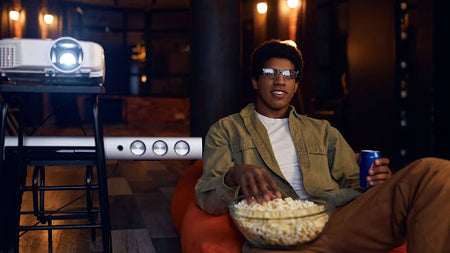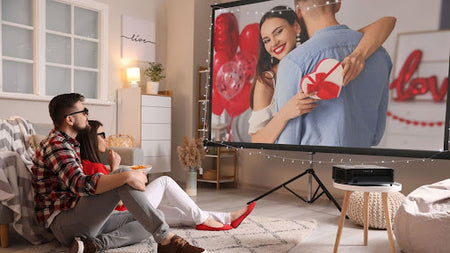Most projectors on the market today are listed as either 720p or 1080p, a term that refers to the resolution of their images. The differences can have a major impact on quality and performance. To help consumers decide which is superior for home theaters or professional presentations, let's compare the two.
What Does 1080p Mean on a Projector?
1080p refers to a screen resolution that is 1920 pixels long by 1080 pixels tall and is almost always used in the 16:9 widescreen format. The "P" refers to progressive scan, which means that each line of the display is drawn in order and every line is used to render the video.
It has become the most popular format for displays and videos in recent years, overtaking the market from its chief rival the interlaced format, listed as "1080i", which has fallen into disuse. Interlaced videos only use odd-numbered lines for rendering video, which results in lower quality.
Is there a Big Difference Between 720p and 1080p Projectors?
There are several key differences between 720p and 1080p projectors, the first of which is the visible difference in image quality. As 1080p has 1.5 times as many pixels, they will naturally produce higher-quality images than their 720p counterparts.
Just as a painter using a smaller brush will be able to shape an image more clearly and delicately than by using a larger one, a higher density of pixels will result in higher definition and greater image clarity.
Color accuracy is another major difference, as 1080p projectors have a greater ability to recreate an image or video's exact coloration than a 720p model would. The higher number of lines and pixels used by 1080p projectors bring with them a greater depth of color and the longer wavelengths of the video signal are capable of transmitting more information.
Perhaps the most important aspect is the detail clarity, which is significantly improved in 1080p. As more pixels can be displayed in the same space, images are less blurred and will have greater definition. When watching a nature documentary, for example, branches on trees in the background will appear more clearly and distinctly in 1080p than in 720p.
How Does Screen Size Affect 720p and 1080p Projector Quality?

Screen size is a massive factor in projector quality, as a larger image will show more detail. If the number "78" appears in a video's background, it'll be much easier to read in a higher definition. Depending on the font, it could look blurry enough to read "10" in 720p.
As the image grows in size, it'll be easier to see quality differences. For example, a movie theater must have the highest possible definition because the screens are between 40 and 70 feet. If the movie has too few pixels, it'll look bad and patrons will be unhappy.
Conversely, with a cell phone or a tablet, the smaller size of the screen makes it harder to tell the difference between 1080p and 720p. As a projector screen is much bigger, the change in quality is much easier to see. This is called "perceived image quality."
Another factor is performance. As the screen grows larger, more power is required from the projector. Many 720p projectors aren't as large as their 1080p counterparts and therefore don't create enough power for high-quality projection. The visual output is also smaller, which makes the image look second-rate.
Can 720P Screen Play 1080p Video?
Through the process of downscaling, 720p projectors can generally play 1080p content. This involves compressing the signal so that it can match the correct wavelength and be properly displayed by the projector. However, it also results in a significant loss of image quality.
Imagine a 1080p video as a piece of paper that needs to travel through a confined space. The paper won't fit but if it's crumpled into a ball, it can pass from one side to the other. Once the paper is straightened out on the other side, it'll still be obvious that it was crumpled. Similarly, compression artifacts and other signs of lower quality will be present when downscaling.
Best 1080p Projectors from WeWatch
WeWatch is a global leader in the projector market and options for home theatre setups, professional presentations, and much more. They also make important accessories like tripods, screens, carrying cases, and remote controls. Let's take a closer look at two of their flagship models for 1080p projectors.
The V50G model is a mini-home projector that offers native 1080p resolution for screens from 36 to 200 inches. It has two cooling fans to support better light efficiency and prevent overheating, and a 75-100% zoom function for maximum enjoyment. The light source has an estimated lifespan of 40,000 hours and offers an amazing 230 ANSI lumens of brightness.
For those who want a more heavy-duty model, the full-sized S1 Projector also has native 1080p resolution but adds support for 4K, as well as an enhanced 50-100% zoom function. It also comes with a smart operating system that includes options for streaming with Amazon Prime, Netflix, and YouTube without requiring any additional inputs.
Both models come with 5W built-in speakers and support a wide variety of inputs, including VGA, USB, HDMI, AV Component Cables, and TransFlash cards (known in America as MicroSD). They also include a 3.5mm headphone jack for users who'd like a more personal experience or would prefer not to disturb those around them. They both also have built-in 2.4 GHz/5 GHz WiFi for enhanced streaming and connectivity.
Conclusion
Higher image quality, better performance, and better color reproduction are just three of the many reasons why a projector 1080p is the superior choice. WeWatch has amazing projectors at great prices and there's no better time than today to purchase one for your work or home.



